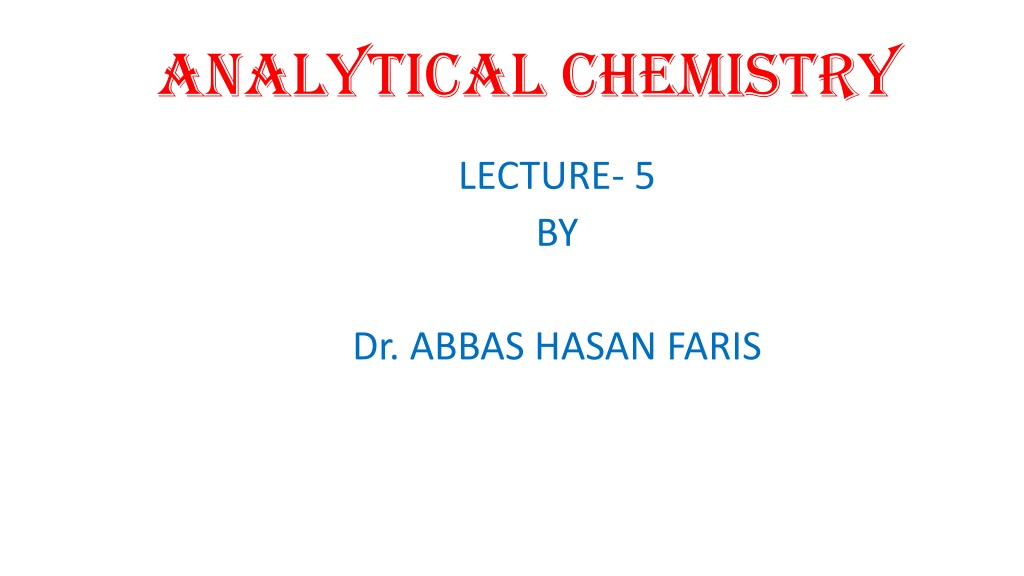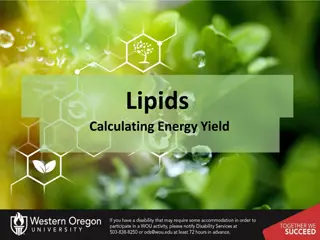Understanding Oxidation-Reduction Reactions in Analytical Chemistry
Oxidation-reduction reactions play a crucial role in various chemical processes, including photosynthesis and corrosion. This content delves into the basics of redox reactions, explaining how electrons are transferred between reactants, leading to changes in oxidation numbers. Examples such as the reaction between zinc and copper sulfate illustrate the concepts of oxidation, reduction, reducing agents, and oxidizing agents. Rules for assigning oxidation numbers are also discussed, providing a comprehensive overview of these fundamental concepts in analytical chemistry.
Download Presentation

Please find below an Image/Link to download the presentation.
The content on the website is provided AS IS for your information and personal use only. It may not be sold, licensed, or shared on other websites without obtaining consent from the author. Download presentation by click this link. If you encounter any issues during the download, it is possible that the publisher has removed the file from their server.
E N D
Presentation Transcript
ANALYTICAL CHEMISTRY LECTURE- 5 BY Dr. ABBAS HASAN FARIS
Oxidation Oxidation- -Reduction Reduction Reactions Reactions An oxidation-reduction reaction is any chemical reaction in which the oxidation number of a molecule, atom, or ion changes by gaining or losing an electron. Redox reactions are common and vital to some of the basic functions of life, including photosynthesis, respiration, combustion, and corrosion or rusting. Often called redox reactions Electrons are transferred between the reactants One substance is oxidized, loses electrons Reducing agent Another substance is reduced, and gains electrons Oxidizing agent Oxidation numbers change during the reaction
4.4 Oxidation-Reduction / Redox Reactions Electron donor Electron acceptor 3
Zn (s) + CuSO4(aq) ZnSO4 (aq) + Cu (s) Zn is oxidized Zn Zn2++ 2e- Cu2+is reduced Cu2++ 2e- Cu Zn is the reducing agent Cu2+is the oxidizing agent Copper wire reacts with silver nitrate to form silver metal. What is the oxidizing agent in the reaction? Cu (s) + 2AgNO3(aq) Cu(NO3)2 (aq) + 2Ag (s) Cu Cu2++ 2e- Ag++ 1e- Ag Ag+is reduced Cu is oxidized Cu is the reducing agent Ag+is the oxidizing agent 4
6.4.4 OxidationReduction (Redox) Reactions An oxidation reduction reaction occurs when electrons move from one reactant to another reactant. As a result of this electron transfer, these reactants undergo a change in oxidation state. Those reactants that experience an increase in oxidation state undergo oxidation, and those experiencing a decrease in oxidation state undergo reduction. For example, in the following redox reaction between Fe3+ and oxalic acid, H2C2O4, iron is reduced because its oxidation state changes from +3 to +2. 2Fe3+ (aq) + H2C2O4 (aq) + 2H2O(l) 2Fe2+ (aq) + 2CO2(g) + 2H3O+ (aq) (6.4.53) Oxalic acid, on the other hand, undergoes oxidation because the oxidation state for carbon increases from +3 in H2C2O4 to +4 in CO2. We can divide a redox reaction, such as reaction 6.4.53, into separate half-reactions that show the oxidation and the reduction processes. H2C2O4 (aq) + 2H2O (l) 2CO2(g) + 2H3O+(aq) + 2e (6.4.54) Fe3+ (aq) + e Fe2+ (aq) (6.4.55) 5
Example Zn(s) + CuSO4(aq) ZnSO4(aq) + Cu(s) Zn(s) + Cu2+(aq) Zn2+(aq) + Cu(s) Zinc is losing 2 electrons and oxidized. Reducing agent Zn(s) Zn2+(aq) + 2e- Copper ions are gaining the 2 electrons. Oxidizing agent Cu2+(aq) + 2e- Cu(s)
Rules for assigning oxidation numbers 1. Elements (uncombined) are 0. Al, N2, He, Zn, Ag, Br2, O2, O3 2. Oxidation numbers must sum to the overall charge of the species. (SO4)2-= -2 (O is usually -2 so .) ? + 4(-2) = -2 Solve: ? - 8 = -2 ? = + 6 (S)
Balancing redox reactions Electrons (charge) must be balanced as well as number and types of atoms Consider this net ionic reaction: Al(s) + Ni2+(aq) Al3+(aq) + Ni(s) The reaction appears balanced as far as the number and type of atoms are concerned, but look closely at the charge on each side.
Al(s) + Ni2+(aq) Al3+(aq) + Ni(s) Divide reaction into two half-reactions Al(s) Al3+(aq) + 3e- Ni2+(aq) + 2e- Ni(s) Multiply by a common factor to equalize electrons (the number of electrons lost must equal number of electrons gained) 2 [Al(s) Al3+(aq) + 3e- ] 3 [Ni2+(aq) + 2e- Ni(s) ]
Cancel electrons and write balanced net ionic reaction 2Al(s) 2Al3+(aq) + 6e- 3Ni2+(aq) + 6e- 3Ni(s) 2Al(s) + 3Ni2+(aq) 2Al3+(aq) + 3Ni(s)























